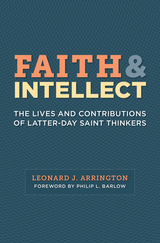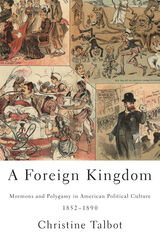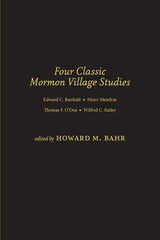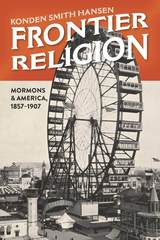115 books about Mormons and 5
start with F
115 books about Mormons and 5
115 books about Mormons
5 start with F start with F
5 start with F start with F

Faith and Intellect
The Lives and Contributions of Latter-day Saint Thinkers
Leonard J Arrington
Signature Books, 2019
Joseph Smith was not the first to found a Christian denomination, but his addition of a new book of scripture on par with the Bible set him and his movement apart. Even before 1830, Smith was both dismissed and admired, embraced and rejected. But most observers agree that he has rightfully earned a significant place in American religious history. Many of the followers he attracted in his day and after have also helped to shape LDS thought. This volume highlights the lives and contributions of Smith, his successor Brigham Young, and eleven others, including Lowell Bennion, Claudia L. Bushman, Hugh Nibley, Chieko Okazaki, B. H. Roberts, James E. Talmage, Laurel Thatcher Ulrich, and Emmeline B. Wells. All together, the women and men profiled here span the nineteenth and twentieth centuries and illuminate what the LDS Church has meant, and continues to mean, to its most thoughtful members.
[more]

A Foreign Kingdom
Mormons and Polygamy in American Political Culture, 1852-1890
Christine Talbot
University of Illinois Press, 2013
The years from 1852 to 1890 marked a controversial period in Mormonism, when the church's official embrace of polygamy put it at odds with wider American culture. In this study, Christine Talbot explores the controversial era, discussing how plural marriage generated decades of cultural and political conflict over competing definitions of legitimate marriage, family structure, and American identity.
In particular, Talbot examines "the Mormon question" with attention to how it constructed ideas about American citizenship around the presumed separation of the public and private spheres. Contrary to the prevailing notion of man as political actor, woman as domestic keeper, and religious conscience as entirely private, Mormons enfranchised women and framed religious practice as a political act. The way Mormonism undermined the public/private divide led white, middle-class Americans to respond by attacking not just Mormon sexual and marital norms but also Mormons' very fitness as American citizens. Poised at the intersection of the history of the American West, Mormonism, and nineteenth-century culture and politics, this carefully researched exploration considers the ways in which Mormons and anti-Mormons both questioned and constructed ideas of the national body politic, citizenship, gender, the family, and American culture at large.
[more]

Four Classic Mormon Village Studies
Howard M. Bahr
University of Utah Press, 2014
Saints Observed: Studies of Mormon Village Life, 1850–2005 serves as a comprehensive introduction to this second volume, which makes available four of the best Mormon village studies, all previously unpublished. These postwar village studies differ substantially from earlier village studies initiated by Nelson’s work and offer in-depth investigations by observers who lived and participated in village life. Together, they capture in rich detail the dayto- day life of mid-century Mormon villagers. Editor Howard Bahr’s afterword highlights changes in the four villages across the past half-century, drawing upon recent site visits, interviews, and texts.
[more]

From Mission to Madness
LAST SON OF THE MORMON PROPHET
Valeen Tippetts Avery
University of Illinois Press, 1998
Brilliant and charismatic, David Hyrum Smith was a poet, painter, singer, philosopher, naturalist, and highly effective missionary for the Reorganized Church of Jesus Christ of Latter Day Saints. In this richly detailed biography, Valeen Tippetts Avery chronicles the life of the last son of Joseph Smith and his first wife, Emma. Avery draws on a large body of correspondence for details of David's life and on his poetry to reveal his personality and emotional struggles. She tells of his mental deterioration, starting with a probable breakdown early in 1870 and ending with his death in 1904 in the Northern Illinois Hospital and Asylum for the Insane in Elgin, where he had been confined for twenty-seven years.
"This is an astonishing accomplishment which not only tells the reader about a neglected historical figure, but about myriad neglected dimensions of both Mormon history and the history of religion in general." -- Jan Shipps, author of Mormonism: The Story of a New Religious Tradition
"This will stand alone as a biography of David H. Smith. . . . But it is also an insightful look at the times and environment from which the Smith family, and its ideas, emerged." -- Paul M. Edwards, author of Our Legacy of Faith: A Brief History of the Reorganized Church
"This is an astonishing accomplishment which not only tells the reader about a neglected historical figure, but about myriad neglected dimensions of both Mormon history and the history of religion in general." -- Jan Shipps, author of Mormonism: The Story of a New Religious Tradition
"This will stand alone as a biography of David H. Smith. . . . But it is also an insightful look at the times and environment from which the Smith family, and its ideas, emerged." -- Paul M. Edwards, author of Our Legacy of Faith: A Brief History of the Reorganized Church
[more]

Frontier Religion
Mormons and America, 1857–1907
Konden Smith Hansen
University of Utah Press, 2019
At the 1893 Columbian Exposition in Chicago, Mormons were deliberately excluded from one of the main attractions, the Parliament of Religions. Organizers believed that Mormonism, with its connections to polygamy, did not merit a place alongside other world religions being showcased for the similar ways in which they inspired people to follow God. At the same time, however, Americans who had long shown hatred or distrust toward their Mormon neighbors had begun to see Mormonism in a different light. Underlying this new view of Mormonism was a rapidly developing belief in America’s fading western frontier as a place linked to core American values such as self-reliance, personal freedom, and democratic rule. With a unique history intimately tied to the frontier, Mormonism began to be seen less as something outside America, and more as a faith closely associated with the country’s most important principles.
In Frontier Religion Konden Smith Hansen examines the dramatic influence these perceptions of the frontier had on Mormonism and other religions in America. Endeavoring to better understand the sway of the frontier on religion in the United States, this book follows several Mormon-American conflicts, from the Utah War and the antipolygamy crusades to the Reed Smoot hearings. The story of Mormonism’s move toward American acceptability represents a larger story of the nation’s transition to modernity and the meaning of religious pluralism. This book challenges old assumptions and provokes further study of the ever changing dialectic between society and faith.
In Frontier Religion Konden Smith Hansen examines the dramatic influence these perceptions of the frontier had on Mormonism and other religions in America. Endeavoring to better understand the sway of the frontier on religion in the United States, this book follows several Mormon-American conflicts, from the Utah War and the antipolygamy crusades to the Reed Smoot hearings. The story of Mormonism’s move toward American acceptability represents a larger story of the nation’s transition to modernity and the meaning of religious pluralism. This book challenges old assumptions and provokes further study of the ever changing dialectic between society and faith.
[more]
READERS
Browse our collection.
PUBLISHERS
See BiblioVault's publisher services.
STUDENT SERVICES
Files for college accessibility offices.
UChicago Accessibility Resources
home | accessibility | search | about | contact us
BiblioVault ® 2001 - 2024
The University of Chicago Press









